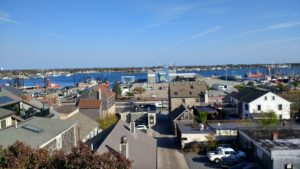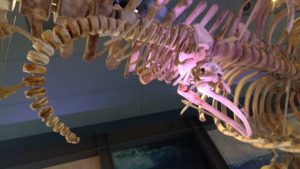Year after year members of the Parks Lab have been attending the North Atlantic right whale (NARW) Consortium Meeting in order to present and discuss science toward the conservation of one of the most endangered and magnificent mammal on Earth. However, the 2016 meeting was especially important to me as it was my conference as an official member of the Parks Lab!
I was so looking foraward to this conference and one of the reasons for that was the meeting venue: the Whaling Museum in New Bedford, MA. The museum was originally dedicated to tell history about the whaling industry in the new Bedford area.

In my opinion though, in addition to the whaling history, the museum hosts one of the most exciting exhibitions about cetacean biology and conservation I have ever seen. My personal favorites: skeletons! From a complete sperm whale to a right whale’s fetus hanging from the selling they were the perfect scenario for this meeting.

Another obvious motive for my excitement was to finally connect faces to all right-whale-references I’ve been citing extensively over the last 4 years. I was positively surprised with how welcoming people were with new arrivals as me and how most of those present have dedicated their entire lives to study and protect the North Atlantic right whale. I felt proud of them and honoured that I am now be able to join them.
Interestingly, the meeting audience was not completely made of scientists. Conservation asks for inputs from the general public, regulators and industry and all this segments had representatives at the Consortium meeting. Among non-scientists a very distinctive group from the Calvin Project, the young, brave and adorable Calvineers deserved especial attention.
But sadly I must confess that after the first morning of presentations I felt sort of depressed and powerless. The North Atlantic right whale population as a whole is not healthy. Whales seemed just too thin (especially when compared to the southern folks- Eubalaena australis) perhaps because the prey aggregations are changing in distribution and abundance. A couple of actively reproductive females, vital to bring new calves into the population, are known to be entangled or died from entanglement in fishing gear. Unfortunately, despite restless efforts there’s no clear solution or obvious measures to help this guys. I can not help tracing a parallel between the north Atlantic Right whale current situation and vaquitas´ population status about 30 years ago. Nowadays we have only about 60 vaquitas left. Could that be fate of NARW as well?
A side from the major concern about the future of right whales, the meeting exceeded all my expectations in terms of science and networking. And most importantly, a life-long lesson was reinforced after my first meeting as Parks Lab member: collaboration is key! Dialog is vital! Listening (not only for whales but to humans as well) is fundamental!
Over here, we will continue to listen for right whales and to work hard to further understand how their behavioural and acoustic ecology is affected by a rapidly changing environment.
Thank you for let me share this great experience with you!
See you next time
Julia Dombroski – Research Assistant
(All opinions and interpretations posted here reflect only my own personal point of view)